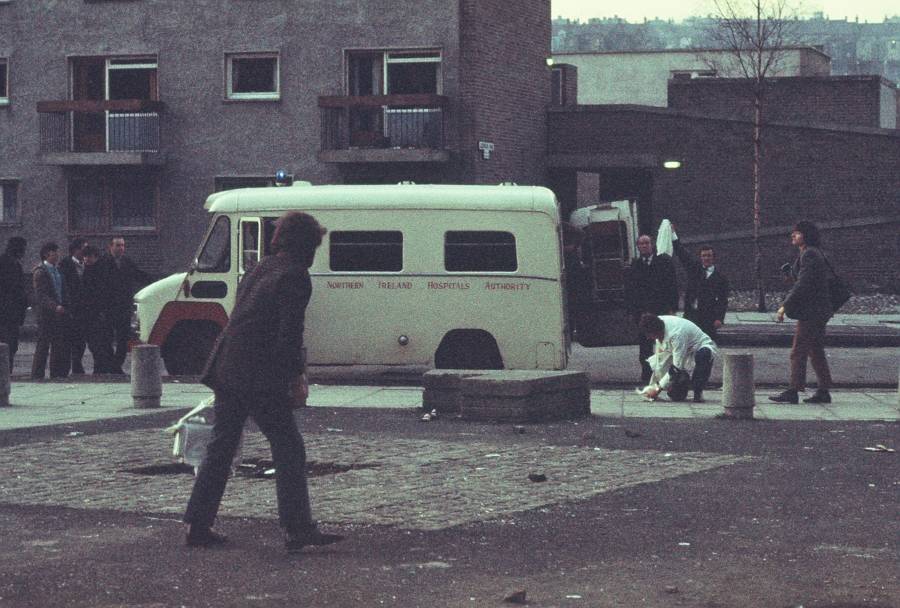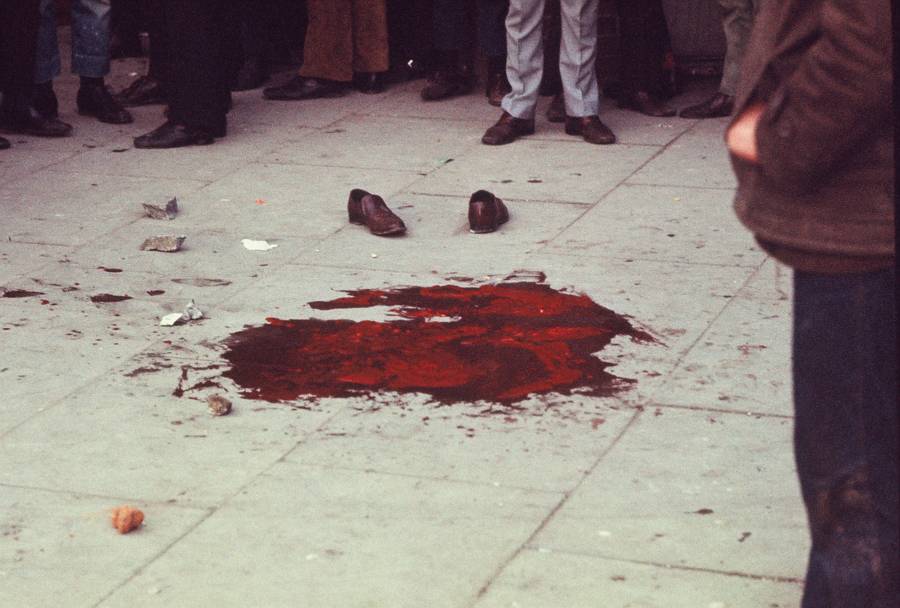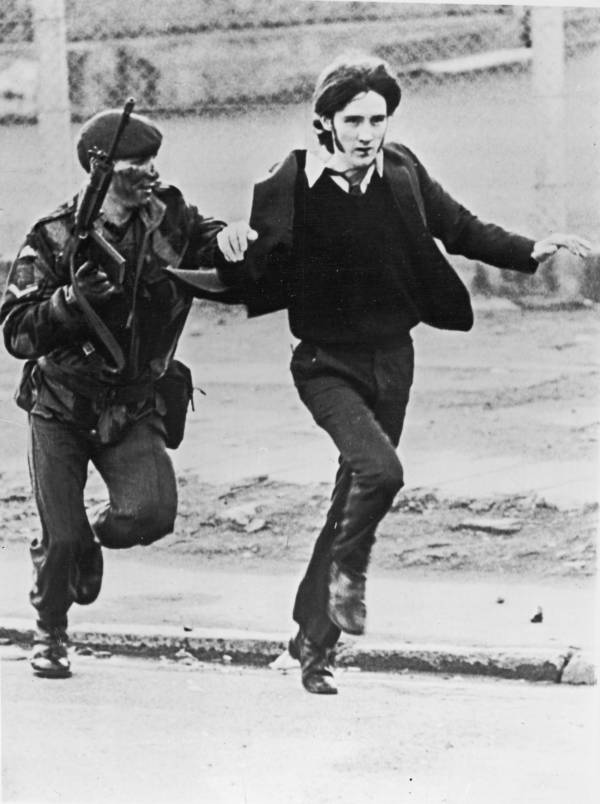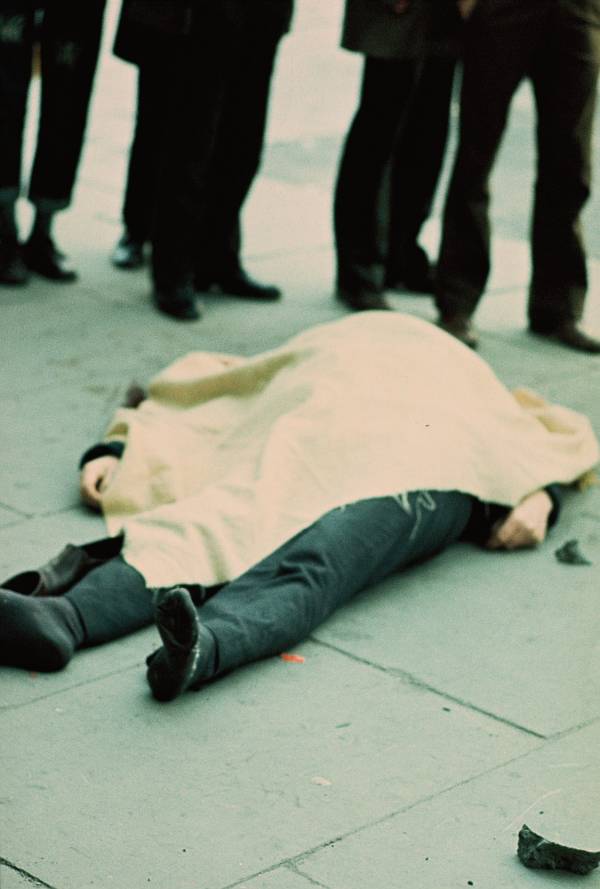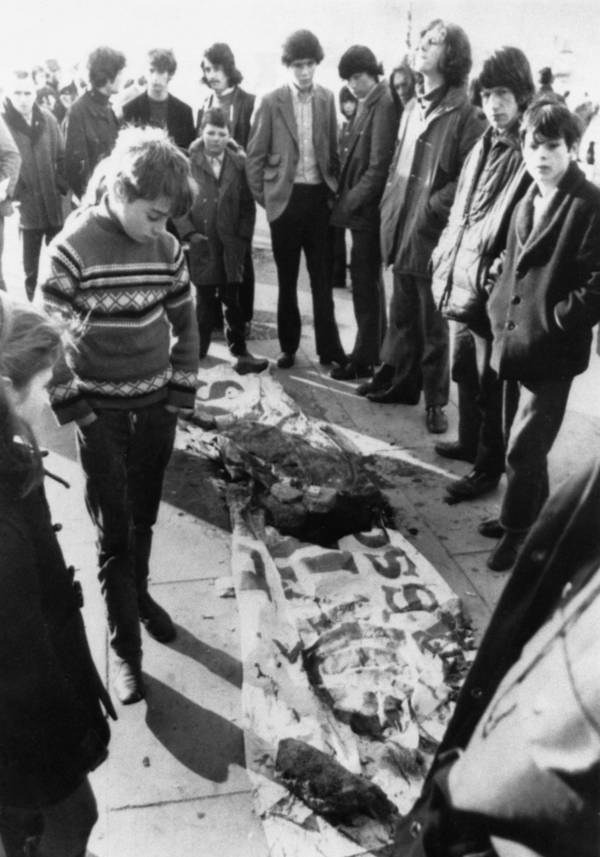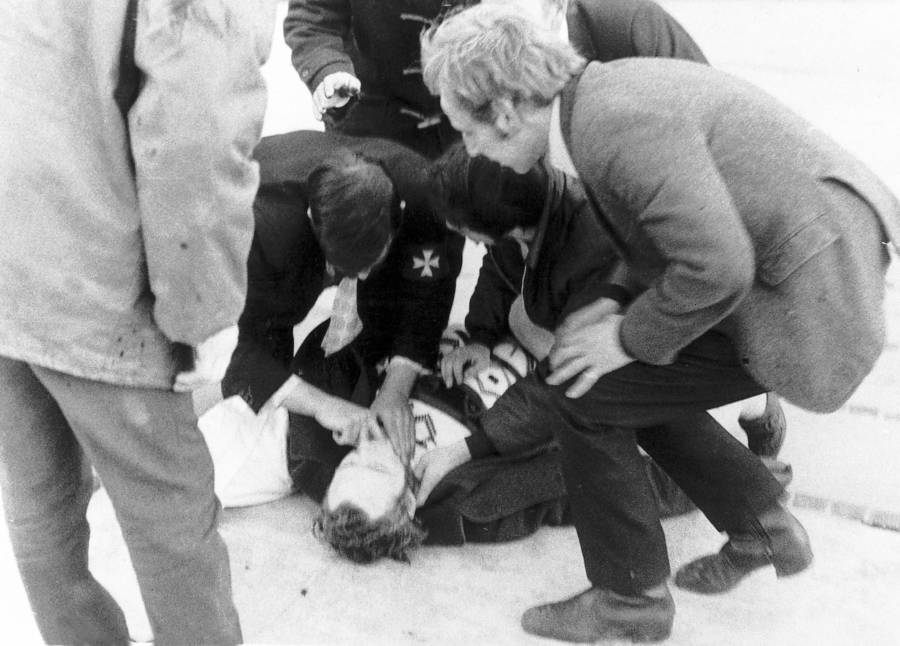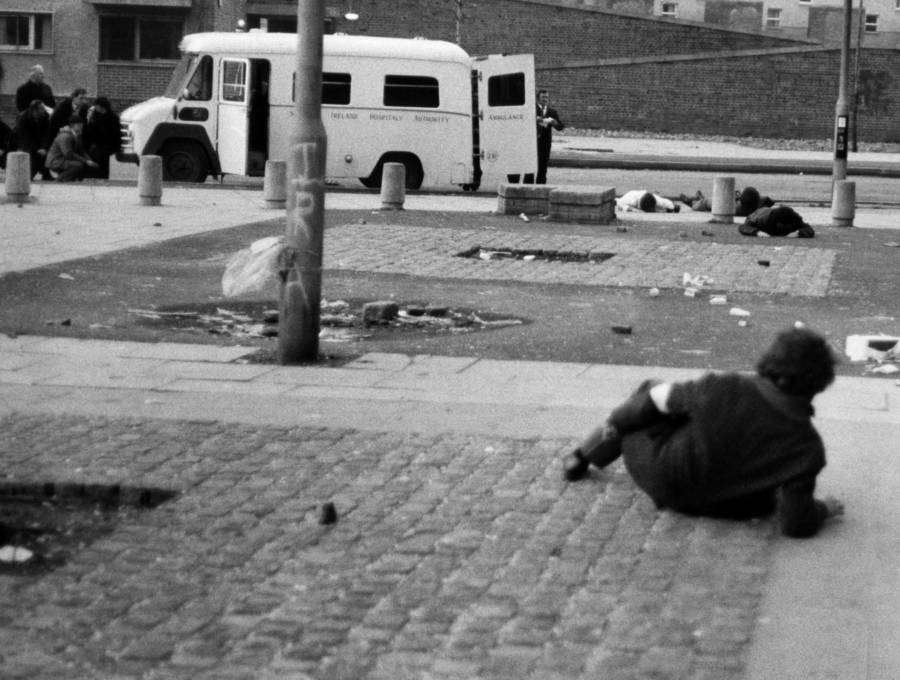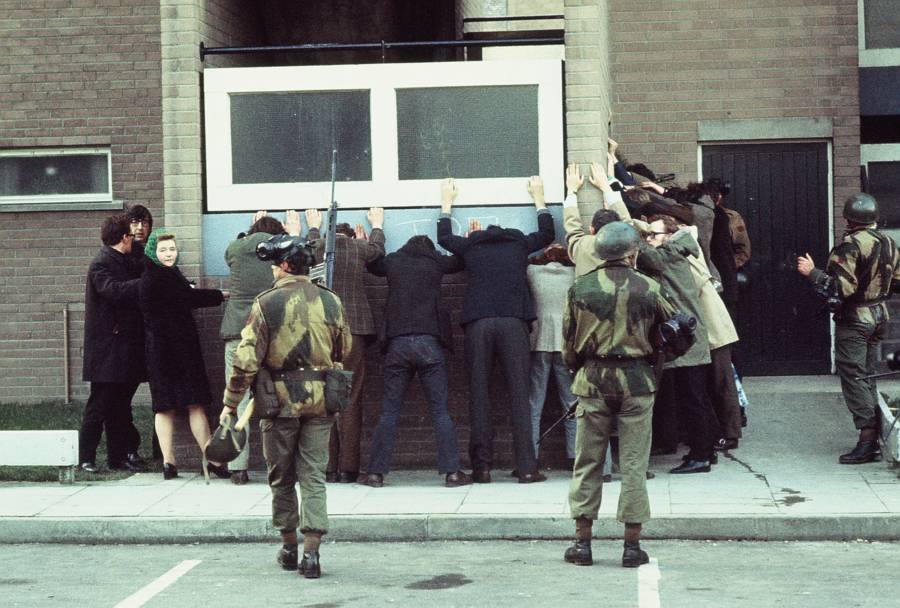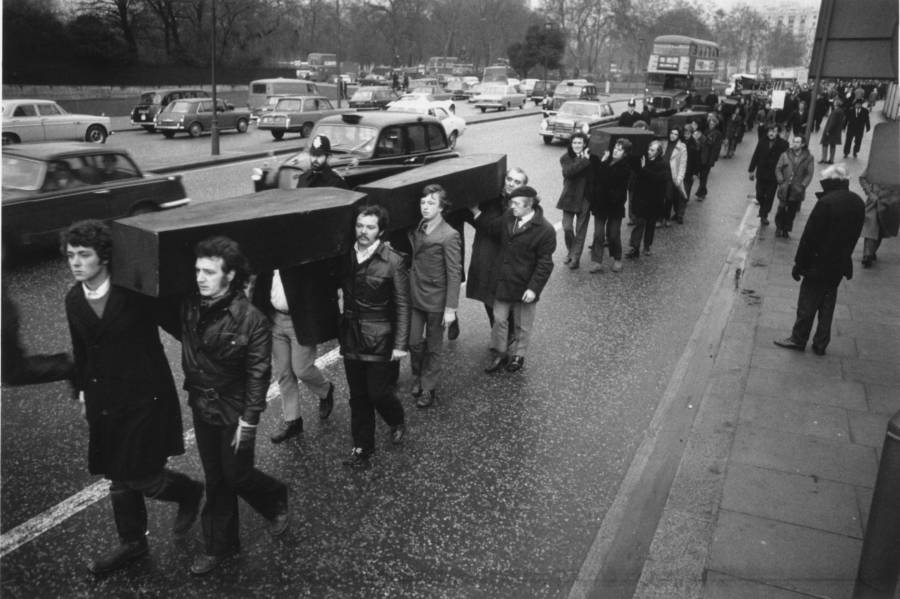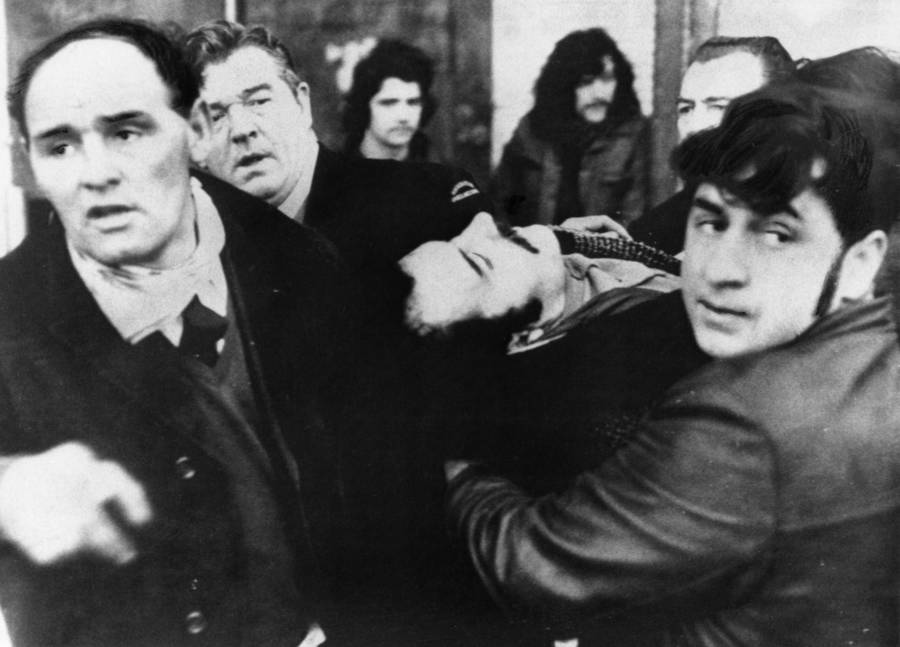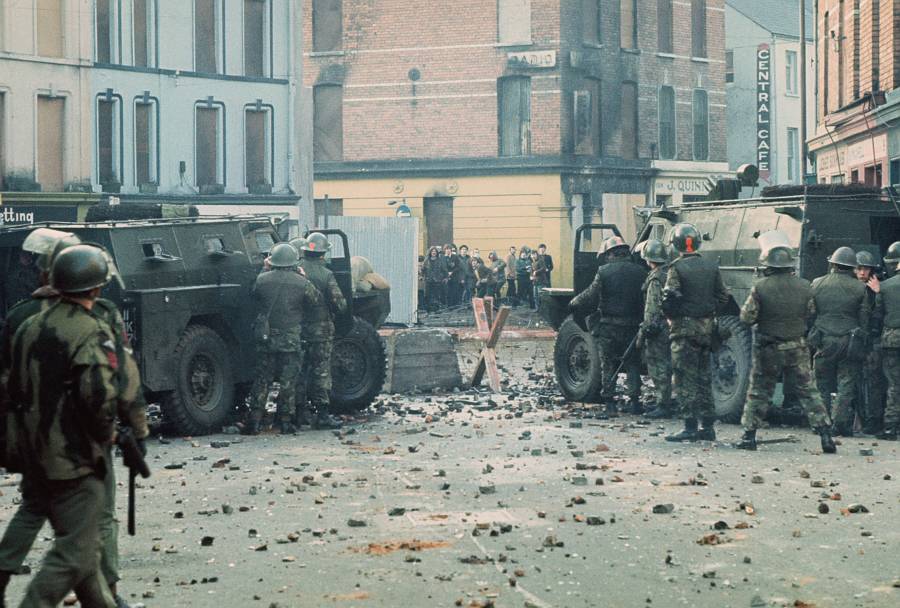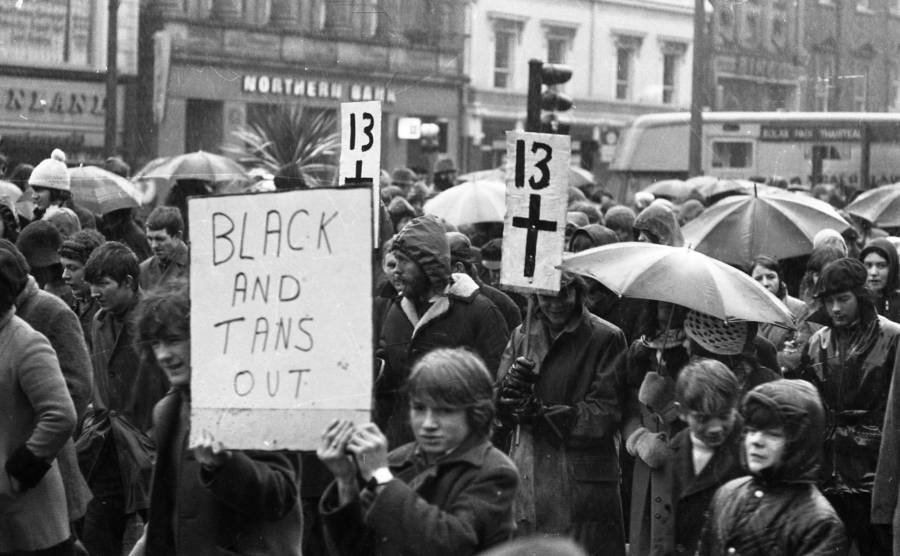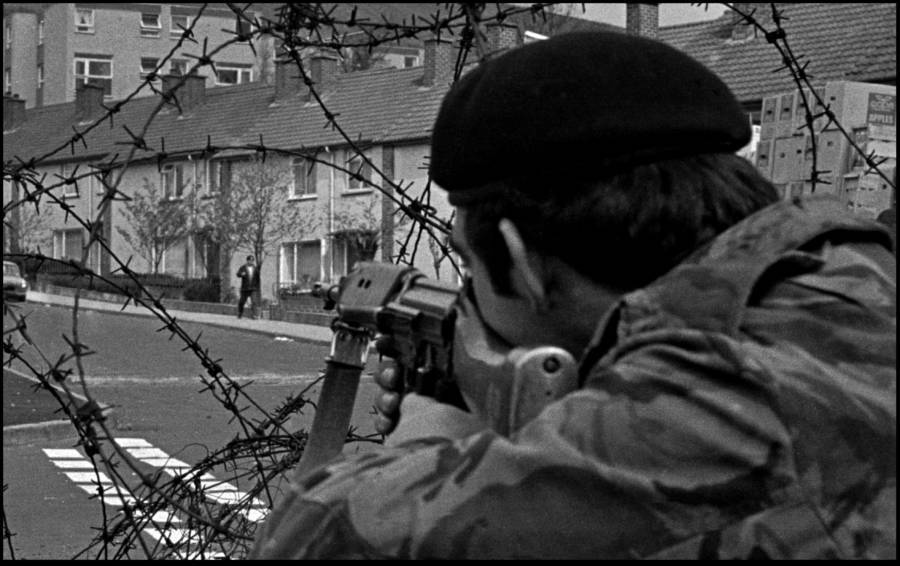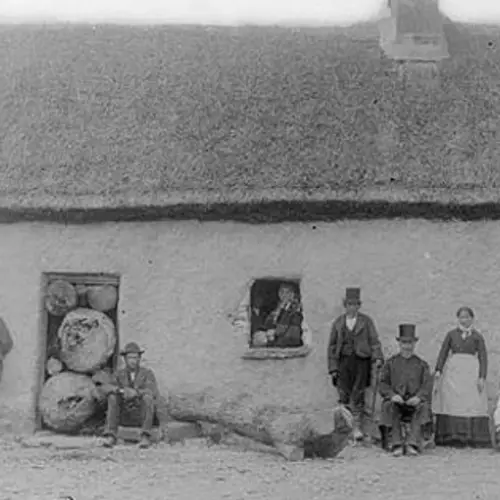On January 30, 1972, British soldiers brutally killed 13 unarmed civilians who were participating in a civil rights march in the Northern Irish city of Derry.
For 30 years between the late 1960s and 1998, Northern Ireland was rocked by The Troubles. Described by some as a “low-level war,” this conflict pitted Irish nationalists against both loyalists and the ruling British government in a battle for sovereignty over Northern Ireland. By the time the hostilities finally ceased, some 3,500 people had been killed in terrorist attacks, paramilitary assaults, and street fights, with more than half of the casualties civilians.
And no single event in the history of The Troubles saw more people killed than the Bloody Sunday massacre. On January 30, 1972, British soldiers stationed in the Northern Irish city of Derry opened fire on crowds of unarmed civilian protesters, killing 13, mortally wounding another, and injuring 15 others with unprecedented brutality.
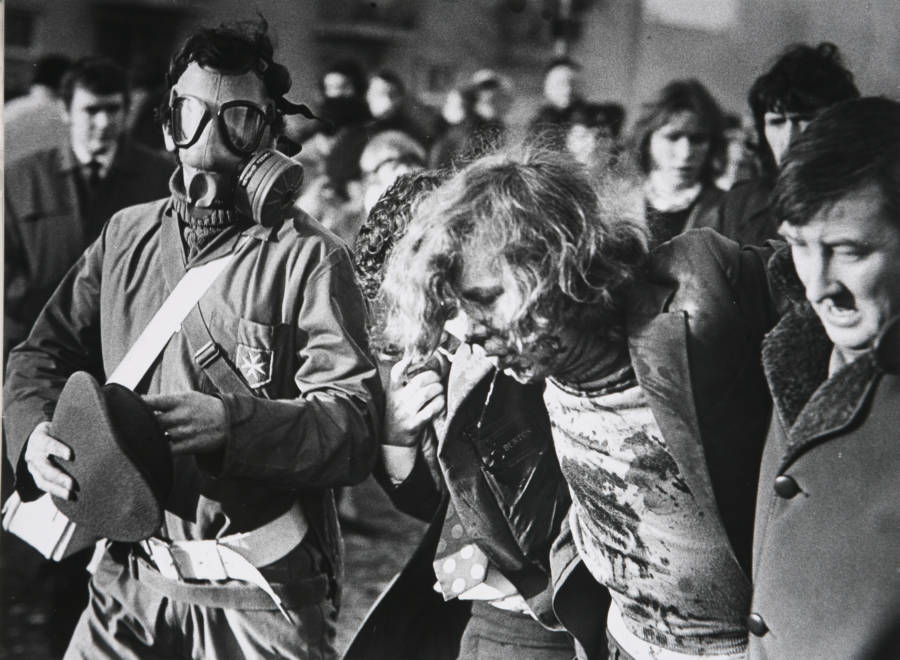
H. Christoph/ullstein bild/Getty ImagesYoung man shot by the British military on Bloody Sunday. Fourteen civilians were killed in the shooting.
In one instance, a boy was fatally shot while crawling away from a charging soldier. Meanwhile, a father of six was killed while trying to help a wounded victim who was waving a white handkerchief. Elsewhere, a man named Michael McKinney lost his brother Willy, who was just 27 years old.
“As I was coming up to Free Derry Corner I saw armored cars and soldiers pushing up towards us. People were running and screaming as they felt the bullets overhead,” recalled McKinney. “When I got back to our house, my father told me: ‘Willy’s dead.’ I just broke down crying.”
Ultimately, the carnage only further mobilized Irish nationalists to take up the fight and keep the conflict going for another 25 years. This is the full story behind Bloody Sunday.
The Centuries-Long History Of Conflict That Preceded Bloody Sunday
The complicated history between Ireland and Great Britain dates back to the 12th century, when English King Henry II invaded Ireland. But the British found it difficult to control the island due to the constant threat of rebelling forces.
Irish rebels resisted the rule of an outside power, as well as changes to their religious practice. England's invasion had the support of Catholic Pope Adrian IV, who feared that Ireland's form of Christianity absorbed too many Pagan influences.
In the 1500s, the dynamic flipped: When King Henry VIII imposed Protestantism on the areas of Ireland under English control, loyalty to the Catholic faith became symbolic of Irish opposition to English rule.
The next century marked the beginning of what's known as the Protestant Ascendancy.
After Protestant English King William III rose to power in 1689, penal laws and exclusionary land bills were implemented to give Protestants in Ireland priority in land ownership. Protestants came to own far more than their fair share of land, while Catholics and Presbyterians were shut out of the Irish House of Commons.
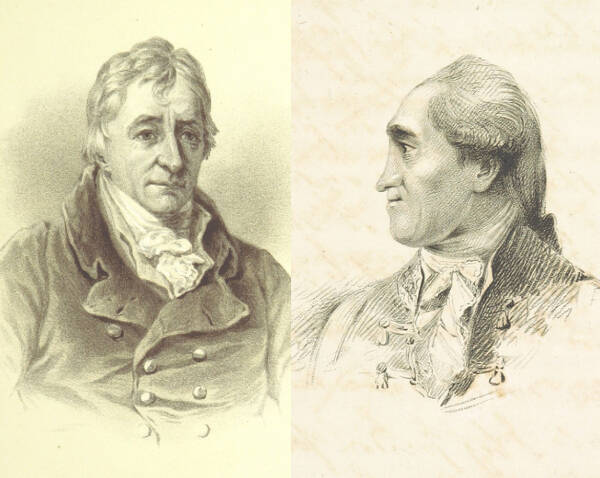

Wikimedia CommonsHenry Grattan (left) and Henry Flood, 18th century leaders of the Irish Patriot Party.
Henry Grattan, a Protestant landowner who sympathized with the marginalized Irish Catholics, campaigned for Irish legislative freedom alongside Henry Flood, who founded the Irish Patriot Party. At the time, the Irish Parliament had to have all of its legislation approved by England, under Poynings' Law.
In 1779, the Party secured a major step toward Irish independence: The British Parliament permitted Ireland to export certain goods and to trade with countries and territories in American, Africa, and the West Indies.
But that wasn't enough. Grattan and the Irish Patriots wanted Ireland to be its own, sovereign, independent country. He spread their message in speeches across the land.
"A great spirit arose among the people, and the speech which I delivered afterwards in the House communicated its fire and impelled them on; the country caught the flame, and it rapidly extended," Grattan wrote of his testimony in front of British Parliament.
"I was supported by eighteen counties, by the grand jury addresses and the resolutions of the [Irish] Volunteers... that was a great day for Ireland—that day gave her liberty."
Grattan's influence in the British parliament combined with the government's strategy to win over Irish loyalty following the revolution that broke out in France, led to the repeal of Poynings' Law in 1782. After the Independent Irish Parliament was formed, Grattan led the parliament between 1783 and 1800.
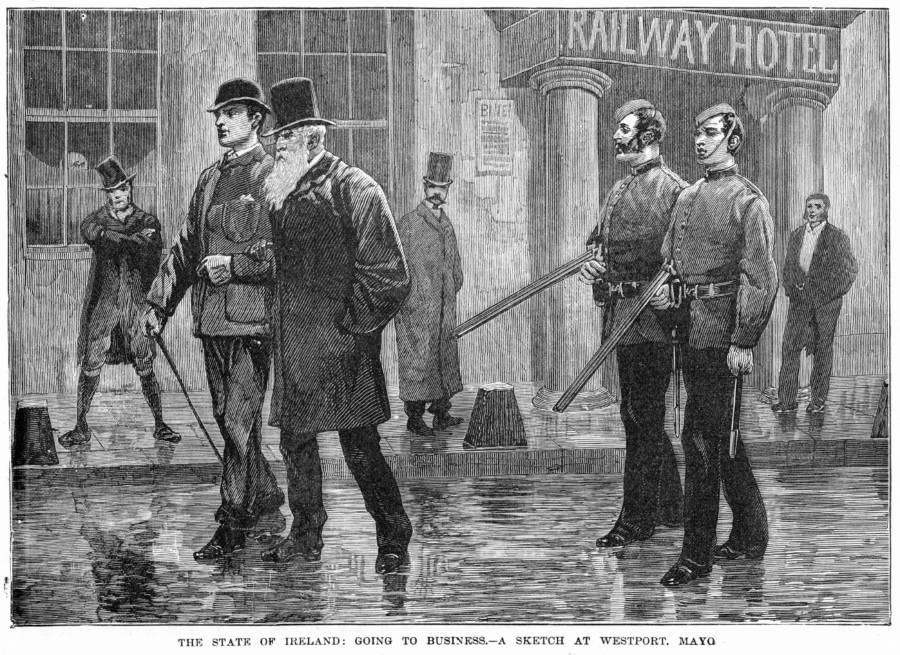

The Print Collector/Print Collector/Getty ImagesSketch of Irish society during the 19th century.
Fearing a newly enfranchised Irish Catholic majority would be bad for England, Britain enacted the Act of Union at the start of 1801, a legislative agreement that bound England, Scotland, Wales, and Ireland together as the United Kingdom.
The merger guaranteed Ireland 100 members in the House of Commons, or about one-fifth of the body's total representation. There would also be free trade between Ireland and the rest of Great Britain, a move that enabled Irish products to be admitted to British colonies on the same terms as British products.
But for some Irish nationalists, that wouldn't be enough, sowing the seeds for a violent clash on Bloody Sunday.
The Partition Of Ireland And Its Lingering Consequences
After World War I broke out in 1914, a group of Irish fed up with British rule tried to stage another rebellion against Britain in the Easter Rising, also known as the Easter Rebellion, while the British were in disarray over the war.
"Ireland unfree shall never be at peace," Easter Rising leader Patrick Pearse famously declared, foreshadowing the gruesome violence that to come in pursuit of an independent Ireland.
The Rising lasted for six days starting on Easter Monday, April 24, 1916. Thousands of armed Irish took to the streets, but were quashed by British forces, who had far superior weaponry.
The uprising had failed and the rebels were executed, but it marked a shift in public opinion against Great Britain and fueled the desire for an independent Ireland.
By this time, Ireland was politically split between those who wanted to remain in the U.K. — mostly Protestants in Ulster province in Northern Ireland — and those who wanted complete independence from Britain, most of whom were Catholic.
For two years starting in 1919, the Irish Republican Army, better known as the IRA, engaged in a guerrilla war for independence with British forces. Well over a thousand people died, and in 1921 a ceasefire was reached and Ireland was partitioned according to the Anglo-Irish Treaty.
Under the new law, the six predominantly Protestant counties of Ulster would remain part of the United Kingdom, while the other 26 predominantly Catholic counties would ultimately become the so-called Irish Free State.
Rather than becoming an independent republic, the Irish Free State would be an autonomous dominion of the British Empire with the British monarch as head of state, like Canada or Australia. Members of the Irish parliament would have to swear an oath of loyalty to King George V.
The treaty broke IRA members into two factions: those who supported the treaty, led by Michael Collins, and those who did not, known as the Irregulars. The Irregulars made up the majority of the IRA's rank-and-file, and the pro-treaty side ultimately became the Irish National Army.
In June 1922, six months after the treaty was signed, the pact between pro and anti-Treaty sides broke down over the inclusion of the British monarch in the Free State's constitution. Elections were held, with the pro-treaty side coming out on top.
In due time, a civil war erupted. The Irish Civil War was a bloody, nearly yearlong ordeal. Many public figures — including Michael Collins — were assassinated, and hundreds of Irish civilians were killed.
Fighting ended with a ceasefire in May 1923, and republican soldiers dumped their arms and returned home, though 12,000 of them were still being held prisoner by the Free State. In August of that year, elections were held and the pro-treaty party won. That October, 8,000 anti-treaty prisoners went on a 41-day hunger strike, to little success; most of them were not released until the following year.
The civil war left an indelible mark on the people and politics of Ireland, cementing a political divide that would only deepen later in the 20th century with The Troubles.
How The Troubles Plagued Northern Ireland


PA Images/Getty ImagesA silent crowd watches the funeral procession of the Bloody Sunday victims.
The Troubles, a 30-year-long series of simmering conflicts, began about 50 years ago, when Catholic Irish nationalists in Northern Ireland who wanted unification with the Irish Republic to the south began a violent campaign against Britain and the Loyalist Protestants who supported continued British rule.
By the late 1960s, increasing civil unrest became the norm. Catholic civil rights marches and counter-protests by Protestant loyalists were exceedingly common, and often led to violent clashes between armed forces — whether against British troops, pro-British paramilitary forces like the Ulster Volunteer Force (UVF), or IRA — and civilian protestors.
One of the earliest violent clashes between civilians and British troops that made headlines was during a protest in Derry (as Irish nationalists call it), or Londonderry (as unionists call it) on October 5, 1968. The city of Derry had been considered the epitome of unionist misrule; despite having a nationalist majority, gerrymandering always returned a unionist majority.
Civil rights protests around the world, including the U.S., fueled activists in Northern Ireland, who called for an end to gerrymandering, voting rights, and housing discrimination that many Catholics experienced in the mostly Protestant pockets of the north.
The Duke Street March, as it was called, had been organized in Derry by local activists with support from the Northern Ireland Civil Rights Association (NICRA).
But what was supposed to be a relatively peaceful march around the neighborhood quickly escalated once British troops arrived to control the masses. Officers whacked protesters with batons and doused them with water cannons. Then, things got ugly.
Deirdre O'Doherty, a protestor who was present at the rally, told the BBC that she fled into a cafe as violence erupted from the police. One officer burst in "with a baton in his hand with the blood dripping off it," O'Doherty recalled. "He was young. He looked vicious. I never saw a face with so much hatred in my life."
A similarly terrifying account of the outburst of violence was shared by another protestor, Grainne McCafferty.
"When the baton charge started by the police we turned to flee, and I remember a wall of policemen across the road blocking our exit route — and a sinking feeling that this is serious trouble," McCafferty said. "Then people started to run in fear."
When O'Doherty, who was a trainee radiographer, returned to her work at the hospital, she "x-rayed about 45 skulls that day" as a result of the police brutality at the protest.
As the Troubles of Northern Ireland worsened, its parliament was suspended and direct British rule was imposed from London in an attempt by the British government to regain control. But things would only escalate further.
The Tragic Story Of The Bloody Sunday Massacre
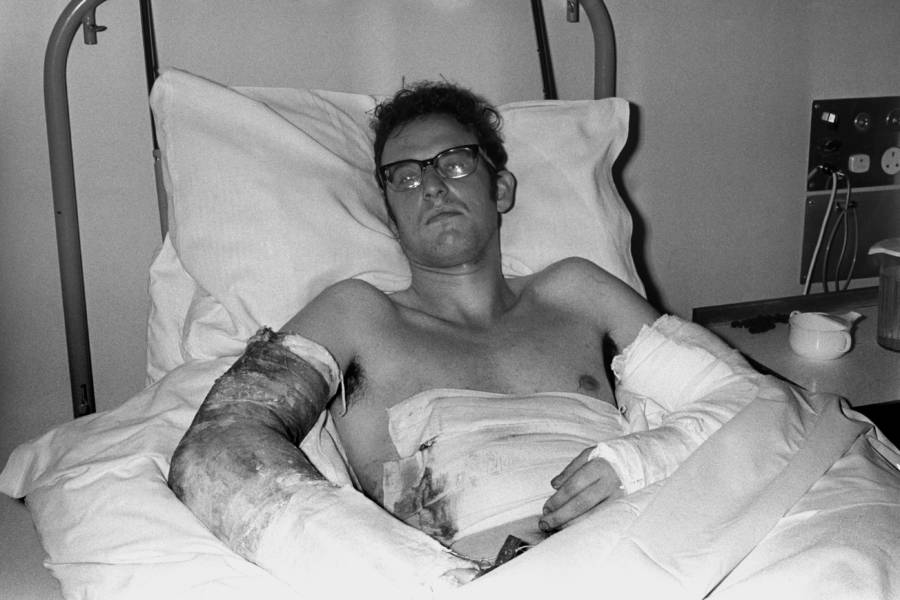

PA Images/Getty ImagesMichael Bradley, 22, was hit in the arms and chest during the Bloody Sunday shootings.
Civil protests continued despite — or perhaps in spite of – repeated attempts from the British government to establish control by sending in British troops to contain protestors.
On Jan. 30, 1972, another protest was held in the Bogside area of Derry, Northern Ireland — where three straight days of riots had occurred in 1969 — in the wake of a recent British policy.
As part of the British Army's Operation Demetrius, civilians were interned without trial. On August 9 and 10, 1971, the British Army detained 342 people suspected of being part of the IRA, and over the next few years nearly 2,000 people would be interned under the policy.
In protest, between 15,000 to 20,000 men, women, and children took to the streets.
Marchers that day had originally planned to head toward Guildhall Square in the city center, but they were blocked by British paratroops. So they headed to the landmark of Free Derry Corner instead.
Some protesters began throwing stones at the British troops manning the barricades. The soldiers fired back with tear gas, rubber bullets, and water cannons. At around 4 o'clock, the troops opened fire.
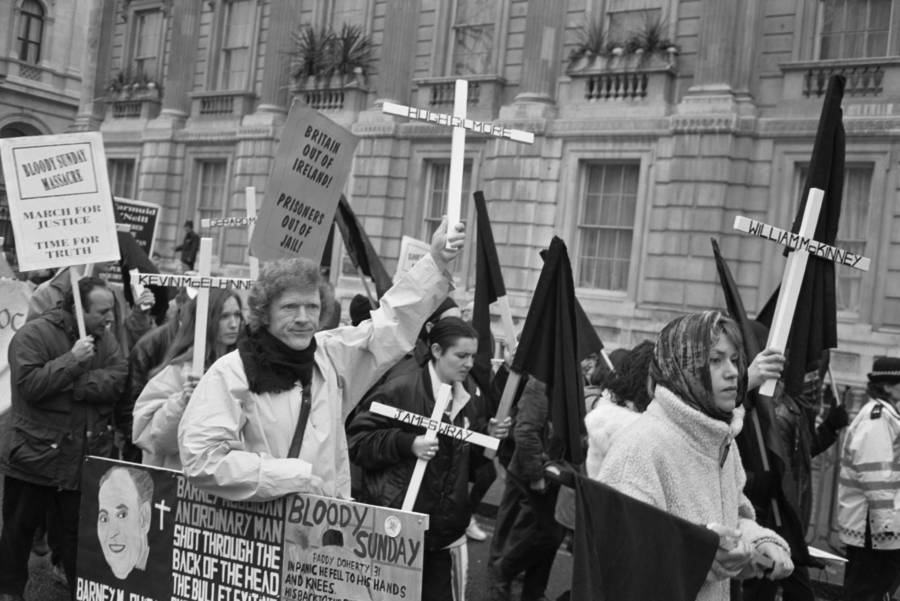

Steve Eason/Hulton Archive/Getty ImagesDemonstrators marching though London on the 27th anniversary of Bloody Sunday.
According to Army evidence, 21 soldiers fired 108 live rounds. Thirteen civilians were shot dead, while a fourteenth died of his wounds months later. Several others were shot or otherwise injured.
Jean Hegarty was living in Canada when she heard that her 17-year-old brother, Kevin McElhinney, was killed.
"I initially saw news reports that six 'gunmen' and 'bombers' had been shot," Hegarty recalled. "I sighed with relief — I didn't know any gunmen or bombers. The next morning an aunt rang and told me: 'Kevin is dead,' He had been crawling away. He was hit in the backside and the bullet travelled up through his body."
Kate Nash, whose brother was killed and whose father was injured, described a scene of horror at the hospital where her father was.
"Nurses and doctors were crying everywhere; on each floor, nurses were crying. People were howling in distress," Nash said. By the time she reached the hospital, her brother's body was already in the morgue.
The violence was deadly and quick; by 4:40 p.m., the shootings had stopped. Thirteen unarmed civilians were killed, and the tragedy earned the name Bloody Sunday.
One of the first casualties of Bloody Sunday was a 17-year-old named John Duddy, who was shot and mortally wounded during the chaos.
A photograph of the teenager being carried away by a group of protestors and a priest, Edward Daly, who was waving a blood-stained white handkerchief as he marched the group to safety, would become one of the most iconic photographs of the Northern Ireland Troubles.
Bernard McGuigan, a father of six children, was later killed by a gunshot to the head while aiding another victim during the massacre — also waving a white handkerchief.
The tragic events of Bloody Sunday did nothing but sow more outrage and division. People took to the streets, enraged by the senseless state-sponsored killings of unarmed civilians. Over the next few decades, the IRA planted bombs throughout Britain, and killed hundreds of members of the British military.
No Justice For The Victims Of Bloody Sunday
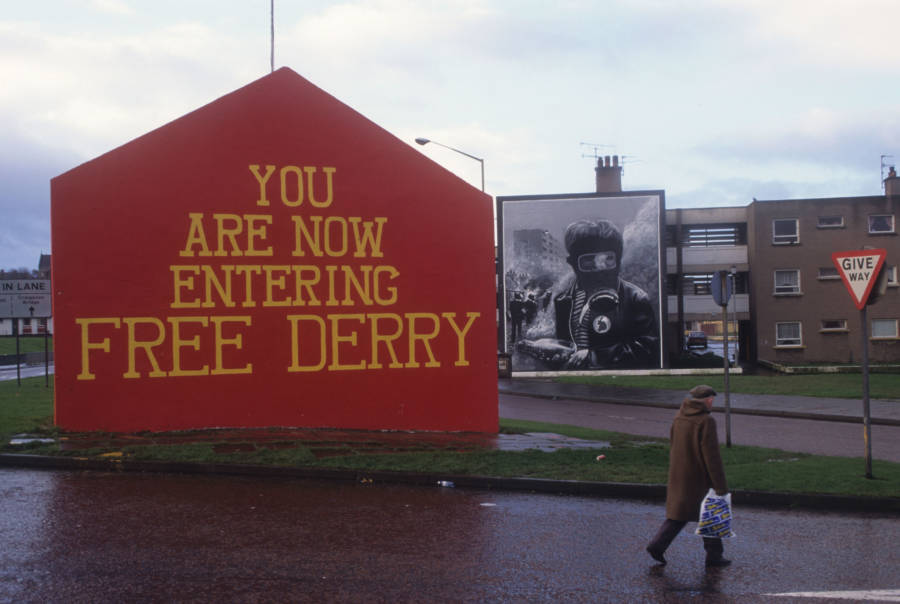

Kaveh Kazemi/Getty ImagesMurals around the town of Derry still send messages of unrest and desire for a free state.
The Troubles mainly ended in 1998 with voter approval of the Good Friday Agreement between Ireland and the U.K., but many people in Northern Ireland still feel the wounds of Bloody Sunday.
It took decades before an official investigation into the events of Bloody Sunday was finally launched. In 2010, Lord Saville's inquiry, which resulted in a 5,000-page report, concluded that none of the Bloody Sunday shootings were justified. Civilians killed in the tragedy, the report declared, had not posed any kind of threat to British troops.
Another of Lord Saville's conclusions was that Major General Robert Ford, then Commander of Land Forces in Northern Ireland, "neither knew nor had reason to know at any stage that his decision would or was likely to result in soldiers firing unjustifiably on that day."
Still, the Army wasn't completely exonerated: Saville found that many of the soldiers interviewed "knowingly put forward false accounts" of shooting at only armed protesters in order to seek to justify their firing".
In 2019, the Police Service of Northern Ireland launched a murder investigation and delivered its findings.
Director of Public Prosecutions for Northern Ireland Stephen Herron said one British soldier, referred to solely as "Soldier F," would face two murder charges for the Bloody Sunday killings of James Wray and William McKinney. But there was "insufficient evidence" to charge 16 other former soldiers involved in the incident.
Nearly 50 years later, families and relatives of the Bloody Sunday victims are still fighting for justice on behalf of their lost loved ones.
"Those soldiers have to face the consequence of what they did," said John Kelly, whose teenage brother Michael was shot and killed that day. "I believe they should get a life sentence. None of them have ever shown any remorse, not at the Saville inquiry or since....My mother never got over the loss of her son."
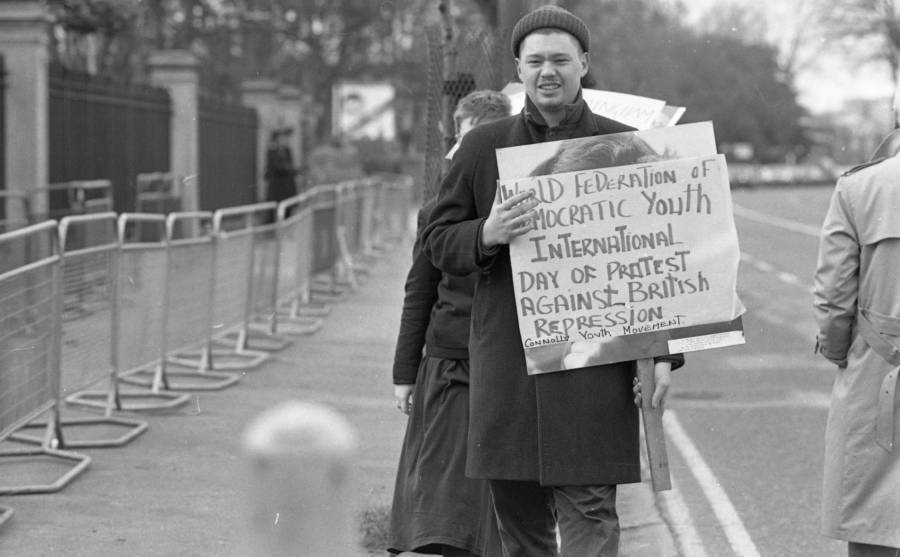

Independent News and Media/Getty ImagesA Bloody Sunday protest march outside the British Embassy in Dublin in 1988.
Many Northern Ireland neighborhoods are deeply segregated between the Catholic nationalists and the Protestant loyalists — segregation made worse by "peace walls," 25-foot barriers erected around neighborhoods meant to keep the two factions from fighting each other.
Groups like the UVF have since been banned by the government as terrorist groups, yet their flags can still be seen waving gingerly on the lampposts of many houses. The divide has even seeped into the lives of the future generation, with more than 90 percent of school children still receiving a segregated education.
"This is a very good illustration of a much deeper problem," said Stephen Farry, a lawmaker from the Alliance Party, which tries to bridge the divides between the Unionists and nationalist communities. "Northern Ireland is not yet a peaceful society. We have ongoing coercive control by paramilitary structures at a local level across many communities."
Politicians from both sides have been criticized for their weak pushback against public shows of the sectarian attitudes leftover from the Northern Ireland conflicts. Even when efforts are made to bridge the divide, those who dare to seek reconciliation are threatened.
Clearly, Northern Ireland still bears the scars of Bloody Sunday, so many years after 1972.
Now that you've learned all about the tragedy of Bloody Sunday in Northern Ireland, read about Bobby Sands, the Irish nationalist who died during a hunger strike. Then, learn the full story of the Tiananmen Square Massacre.
